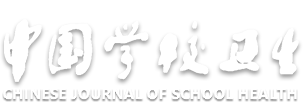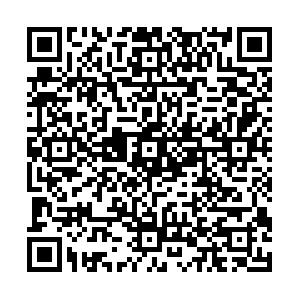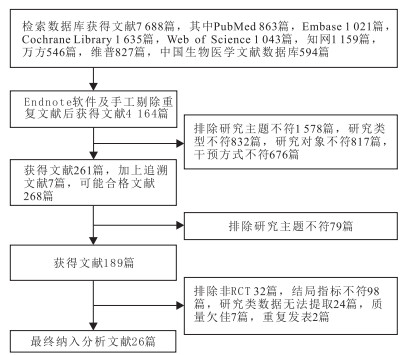Meta-analysis of the effects of different intervention modalities on non-suicidal self-injury in adolescents
-
摘要:
目的 探讨不同干预方式对青少年非自杀性自伤(NSSI)的干预效果,为制定青少年NSSI的干预策略提供循证依据。 方法 检索中国知网、万方、维普、中国生物医学文献数据库、Web of Science、PubMed、Embase、Cochrane Library等数据库,筛选有关青少年NSSI干预的随机对照研究,检索时间为建库至2025年3月5日。运用Stata 17.0和Review Manager 5.3软件进行网状Meta分析,以标准均数差(SMD)及95%CI为效应指标,比较各干预方式之间的效果差异,并进行效果排序。 结果 最终纳入26篇文献,共2 034名NSSI青少年,包括辩证行为疗法、情绪调节干预、心智化基础疗法、家庭干预、削减计划、认知行为疗法、叙事治疗、阶梯式护理干预、积极心理干预、接纳承诺疗法10种干预方式。结果显示,与常规干预组相比,积极心理干预[SMD值(95%CI)=-2.12(-3.51~-0.74)]、阶梯式护理干预[SMD值(95%CI)=-2.07(-3.43~-0.71)]、辩证行为疗法[SMD值(95%CI)=-1.70(-2.60~-0.80)]、认知行为疗法[SMD值(95%CI)=-1.54(-2.61~-0.48)]、接纳承诺疗法[SMD值(95%CI)=-1.50(-2.68~-0.32)]在减轻青少年NSSI行为方面差异均有统计学意义(P值均<0.05)。积极心理干预、阶梯式护理干预、辩证行为疗法效果均优于心智化基础疗法及削减计划(SMD值分别为-2.08,-2.03,-1.66,-2.06,-2.01,-1.64,P值均<0.05);累积排序概率图下面积显示,积极心理干预在改善青少年NSSI上效果可能更好(82.5)。 结论 积极心理干预在多种干预方式中表现出对青少年NSSI最佳的改善效果,推荐在临床干预中优先考虑。 Abstract:Objective To explore the effectiveness of different intervention modalities on non-suicidal self-injury (NSSI) in adolescents, so as to provide an evidence-based basis for the intervention strategy of NSSI in adolescents. Methods Randomized controlled trials on interventions for adolescent NSSI were retrieved from databases, such as CNKI, Wanfang, VIP, CBM, Web of Science, PubMed, Embase, and Cochrane Library, spanning from the inception of these databases to March 5, 2025. Network Meta-analysis was performed by using Stata 17.0 and Review Manager 5.3 software, and the standardized mean difference (SMD) and 95%CI were used as the effect indicators to compare the differences in the effectiveness of the interventions and rank the effect. Results A total of 26 articles with 2 034 adolescents with NSSI were included in the study, including 10 intervention modalities: dialectical behavior therapy, emotional regulation intervention, mentalization-based therapy, family therapy, cutting down programme, cognitive behavioral therapy, narrative therapy, stepped care approach, positive psychological intervention, and acceptance and commitment therapy. The results showed that compared with the treatment as usual, positive psychological intervention [SMD(95%CI)=-2.12(-3.51 to-0.74)], stepped care intervention [SMD(95%XI)=-2.07(-3.43 to-0.71)], and dialectical behavior therapy [SMD(95%CI)=-1.70(-2.60 to-0.80)], cognitive behavioral therapy [SMD(95%CI)=-1.54(-2.61 to-0.48)], and acceptance and commitment therapy [SMD(95%CI)=-1.50(-2.68 to-0.32)] were statistically significant differences in reducing adolescents' NSSI behaviors(P < 0.05). Positive psychological intervention, stepped care intervention, and dialectical behavior therapy were more effective than the mentalization-based therapy and the cutting down programme (SMD=-2.08, -2.03, -1.66, -2.06, -2.01, -1.64, P < 0.05); the area under the cumulative ranking probability graph revealed that positive psychological intervention may have the best effect in improving NSSI among adolescents (82.5). Conclusions Positive psychological interventions show the best results in improving adolescent NSSI among multiple intervention modalities. It is recommended to give priority to positive psychological interventions in clinical interventions. -
Key words:
- Intervention /
- Self-injurious behavior /
- Mental health /
- Meta-analysis /
- Adolescent
1) 利益冲突声明 所有作者声明无利益冲突。 -
表 1 不同干预方式对青少年NSSI影响纳入文献的基本特征
Table 1. Basic characteristics of included literature on screening process of the effects of different intervention modalities on NSSI in adolescents
第一作者与年份 国家 年龄/岁 样本量 干预方式 干预时间/min 干预频次 干预周期 测评工具 试验组 对照组 试验组 对照组 试验组 对照组 Mehlum[14](2014) 挪威 15.9±1.4 15.3±1.6 39 38 DBT TAU 60~120 1次/周 19周 LPC Morthorst[15](2022) 丹麦 15.2±1.3 14.9±1.4 15 15 ERI TAU — 1次/周 12周 DSHI Rossouw[16](2012) 英国 15.4±1.3 14.8±1.2 40 40 MBT TAU 50 1次/周 3月 RTSHI-A Haga[17](2018) 挪威 15.9±1.4 15.3±1.6 39 38 DBT TAU 60~120 1~2次/周 19周 LPC Bjureberg[18](2023) 瑞典 15.0±1.3 15.0±1.2 77 77 ERI TAU — 1次/周 12周 DSHI Cottrell[19](2018) 美国 14.3±1.4 14.4±1.4 73 56 FT TAU 85 1次/月 12月 SASII Beck[20](2020) 丹麦 15.7±1.1 15.9±1.0 39 45 MBT TAU 90 1次/周 30周 RTSHI-A Griffiths[21](2019) 英国 15.4±1.3 15.7±1.4 22 26 MBT TAU 85 1次/周 12周 RTSHI-A Kaess[22](2020) 瑞士 14.6±1.3 15.2±1.1 37 37 CDP TAU — 1次/周 2~4月 SITBI Rockstroh[23](2023) 德国 14.2±1.2 14.2±1.2 36 36 CDP TAU — 1次/周 6月 SITBI 章明慧[24](2024) 中国 11.1±1.5 11.3±1.5 71 71 DBT TAU — — 8周 ANSAQ 王玉萍[25](2022) 中国 15.7±3.1 15.5±2.9 44 42 CBT TAU 60~90 1次/周 5周 ANSAQ 张雅怡[26](2024) 中国 15.0±1.5 14.9±1.5 26 29 NT SPI 60 2次/周 3周 青少年自我伤害问卷 张春娜[27](2023) 中国 14.4±2.4 14.8±2.1 44 44 NT TAU 60 1次/周 - ANSAQ 曹玉婷[28](2024) 中国 15.8±1.8 15.7±1.9 50 50 SCA TAU 30 2~4次/周 6周 ANSAQ 陈琳[29](2023) 中国 12~18 12~18 44 46 SCA TAU 30 2~3次/周 2周 青少年自我伤害问卷 梁巧玲[30](2022) 中国 15.9±2.5 16.2±2.3 38 38 PPI TAU 60~80 1次/周 3月 青少年自我伤害问卷 韩利[31](2023) 中国 16.1±0.7 16.1±0.7 43 44 FT TAU 60 1次/周 8周 OSI 胡知仲[32](2022) 中国 16.1±1.7 14.8±1.7 12 12 ACT DBT 90 1次/周 8周 ANSAQ 苏晓云[33](2022) 中国 16.3±1.3 16.2±1.5 45 45 DBT TAU — — 6周 ANSAQ 张岩岩[34](2023) 中国 12~18 12~18 15 15 ACT TAU 60 1次/周 8周 ANSAQ 彭惠子[35](2021) 中国 15.1±1.5 15.7±1.7 15 15 CBT SPI 60 1~2次/周 6周 青少年自我伤害问卷 陈秋雨[36](2023) 中国 15.5±1.7 15.5±2.1 19 20 CBT TAU 30 2次/周 4周 ANSAQ 薛毅[37](2022) 中国 14.2±1.7 14.7±1.5 60 60 ACT TAU 30~50 1次/周 6周 ANSAQ 李国红[38](2024) 中国 15.3±2.2 14.3±2.3 30 30 PPI TAU 60~80 1次/周 2月 OSI 娄凤艳[39](2024) 中国 15.8±0.7 15.9±0.8 46 46 CBT TAU 60~90 1次/周 5周 ANSAQ 注:LPC—终生自杀计数访谈;DSHI—蓄意自伤问卷;SITBI—自我伤害想法和行为访谈;RTSHI-A—青少年冒险和自残量表;SASII—自杀未遂自伤访谈;ANSAQ—青少年非自杀性自伤行为问卷;OSI—渥太华自伤量表;TAU—常规干预;SPI—支持性心理干预。 -
[1] GHINEA D, FUCHS A, PARZER P, et al. Psychosocial functioning in adolescents with non-suicidal self-injury: the roles of childhood maltreatment, borderline personality disorder and depression[J]. Borderline Person Disord Emot Dysregul, 2021, 8(1): 21. doi: 10.1186/s40479-021-00161-x [2] BROWN R C, PLENER P L. Non-suicidal self-injury in adolescence[J]. Curr Psychiatry Rep, 2017, 19(3): 20. doi: 10.1007/s11920-017-0767-9 [3] SWANNELL S V, MARTIN G E, PAGE A, et al. Prevalence of nonsuicidal self-injury in nonclinical samples: systematic review, Meta-analysis and Meta-regression[J]. Suicide Life Threat Behav, 2014, 44(3): 273-303. doi: 10.1111/sltb.12070 [4] QU D, WEN X, LIU B, et al. Non-suicidal self-injury in Chinese population: a scoping review of prevalence, method, risk factors and preventive interventions[J]. Lancet Reg Health West Pac, 2023, 37: 100794. http://www.sciencedirect.com/science/article/pii/S2666606523001128 [5] WANG X, HUANG X, HUANG X, et al. Parents' lived experience of adolescents' repeated non-suicidal self-injury in China: a qualitative study[J]. BMC Psychiatry, 2022, 22(1): 70. doi: 10.1186/s12888-022-03715-7 [6] WITT K G, HETRICK S E, RAJARAM G, et al. Interventions for self-harm in children and adolescents[J]. Cochrane Database Syst Rev, 2021, 3: CD013667. [7] 张俊蕾, 赵玉洁, 彭莎栗, 等. 辩证行为疗法对青少年非自杀性自伤行为患者认知情绪调节的影响[J]. 中国学校卫生, 2023, 44(12): 1784-1787.ZHANG J L, ZHAO Y J, PENG S L, et al. Effects of dialectical behavior therapy on cognitive emotion regulation in adolescents with non-suicidal self-injury behaivor[J]. Chin J Sch Health, 2023, 44(12): 1784-1787. (in Chinese) [8] BAHJI A, PIERCE M, WONG J, et al. Comparative efficacy and acceptability of psychotherapies for self-harm and suicidal behavior among children and adolescents: a systematic review and network Meta-analysis[J]. JAMA Netw Open, 2021, 4(4): e216614. doi: 10.1001/jamanetworkopen.2021.6614 [9] LU J, GAO W, WANG Z, et al. Psychosocial interventions for suicidal and self-injurious-related behaviors among adolescents: a systematic review and Meta-analysis of Chinese practices[J]. Front Public Health, 2023, 11: 1281696. doi: 10.3389/fpubh.2023.1281696 [10] 曾宪涛, 曹世义, 孙凤, 等. Meta分析系列之六: 间接比较及网状分析[J]. 中国循证心血管医学杂志, 2012, 4(5): 399-402. doi: 10.3969/j.issn.1674-4055.2012.05.003ZENG X T, CAO S Y, SUN F, et al. Meta-analysis series part VI: indirect comparison and network Meta-analysis[J]. Chin J Evid Based Cardiovasc Med, 2012, 4(5): 399-402. (in Chinese) doi: 10.3969/j.issn.1674-4055.2012.05.003 [11] PAGE M J, MCKENZIE J E, BOSSUYT P M, et al. Updating guidance for reporting systematic reviews: development of the PRISMA 2020 statement[J]. J Clin Epidemiol, 2021, 134: 103-112. doi: 10.1016/j.jclinepi.2021.02.003 [12] American Psychiatric Association. Diagnostic and statistical manual of mental disorders[M]. 5th ed. Arlington: American Psychiatric Publishing, 2013: 803-806. [13] HIGGINS J P, ALTMAN D G, GØTZSCHE P C, et al. The Cochrane collaboration's tool for assessing risk of bias in randomised trials[J]. BMJ, 2011, 343: d5928. doi: 10.1136/bmj.d5928 [14] MEHLUM L, TØRMOEN A J, RAMBERG M, et al. Dialectical behavior therapy for adolescents with repeated suicidal and self-harming behavior: a randomized trial[J]. J Am Acad Child Adolesc Psychiatry, 2014, 53(10): 1082-1091. doi: 10.1016/j.jaac.2014.07.003 [15] MORTHORST B, OLSEN M H, JAKOBSEN J C, et al. Internet based intervention (emotion regulation individual therapy for adolescents) as add-on to treatment as usual versus treatment as usual for non-suicidal self-injury in adolescent outpatients: the TEENS randomised feasibility trial[J]. JCPP Adv, 2022, 2(4): e12115. doi: 10.1002/jcv2.12115 [16] ROSSOUW T I, FONAGY P. Mentalization-based treatment for self-harm in adolescents: a randomized controlled trial[J]. J Am Acad Child Adolesc Psychiatry, 2012, 51(12): 1304-1313. e1303. doi: 10.1016/j.jaac.2012.09.018 [17] HAGA E, AAS E, GRØHOLT B, et al. Cost-effectiveness of dialectical behaviour therapy vs. enhanced usual care in the treatment of adolescents with self-harm[J]. Child Adolesc Psychiatry Ment Health, 2018, 12: 22. [18] BJUREBERG J, OJALA O, HESSER H, et al. Effect of Internet-delivered emotion regulation individual therapy for adolescents with nonsuicidal self-injury disorder: a randomized clinical trial[J]. JAMA Network Open, 2023, 6(7): e2322069. doi: 10.1001/jamanetworkopen.2023.22069 [19] COTTRELL D J, WRIGHT-HUGHES A, COLLINSON M, et al. A pragmatic randomised controlled trial and economic evaluation of family therapy versus treatment as usual for young people seen after second or subsequent episodes of self-harm: the self-harm intervention: family therapy (SHIFT) trial[J]. Health Technol Assess, 2018, 22(12): 1-222. doi: 10.3310/hta22120 [20] BECK E, BO S, JØRGENSEN M S, et al. Mentalization-based treatment in groups for adolescents with borderline personality disorder: a randomized controlled trial[J]. J Child Psychol Psychiatry, 2020, 61(5): 594-604. doi: 10.1111/jcpp.13152 [21] GRIFFITHS H, DUFFY F, DUFFY L, et al. Efficacy of Mentalization-based group therapy for adolescents: the results of a pilot randomised controlled trial[J]. BMC Psychiatry, 2019, 19(1): 167. doi: 10.1186/s12888-019-2158-8 [22] KAESS M, EDINGER A, FISCHER-WALDSCHMIDT G, et al. Effectiveness of a brief psychotherapeutic intervention compared with treatment as usual for adolescent nonsuicidal self-injury: a single-centre, randomised controlled trial[J]. Eur Child Adolesc Psychiatry, 2020, 29(6): 881-891. doi: 10.1007/s00787-019-01399-1 [23] ROCKSTROH F, EDINGER A, JOSI J, et al. Brief psychotherapeutic intervention compared with treatment as usual for adolescents with nonsuicidal self-injury: outcomes over a 2-4-year follow-up[J]. Psychother Psychosom, 2023, 92(4): 243-254. doi: 10.1159/000531092 [24] 章明慧, 徐瑶燕, 张莎莎, 等. 基于辩证行为疗法理念的认知行为干预对青少年自伤负性情绪及生活质量的影响[J]. 中国妇幼保健, 2024, 39(6): 1051-1054.ZHANG M H, XU Y Y, ZHANG S S, et al. The impact of cognitive behavioral intervention based on dialectical behavior therapy on non-suicidal self-injury, negative emotions, and quality of life among adolescents[J]. Matern Child Health Care China, 2024, 39(6): 1051-1054. (in Chinese) [25] 王玉萍, 梁嘉权, 潘锦环, 等. 青少年认知行为疗法在青少年非自杀性自伤中的应用[J]. 循证护理, 2022, 8(14): 1921-1926.WANG Y P, LIANG J Q, PAN J H, et al. Application of adolescent cognitive behavior therapy in adolescent non-suicidal self-injury[J]. Chin Evid Based Nurs, 2022, 8(14): 1921-1926. (in Chinese) [26] 张雅怡, 李晓娟, 李明玉, 等. 叙事治疗对青少年抑郁症患者非自杀性自伤的干预效果: 一项前瞻性随机对照研究. 中国当代儿科杂志, 2024, 26(2): 124-130.ZHANG Y Y, LI X J, LI M Y, et al. Intervention effect of narrative therapy on non-suicidal self-injury in adolescents with depressive disorder: a prospective randomized controlled study. Chin J Contemp Pediatr, 2024, 26(2): 124-130. (in Chinese) [27] 张春娜, 丘顺如, 林欢, 等. 叙事治疗应用于青少年非自杀性自伤行为的效果[J]. 心理月刊, 2023, 18(22): 198-200.ZHANG C N, QIU S R, LIN H, et al. The effect of narrative therapy on adolescent non-suicidal self-injury behavior[J]. Psychol Magaz, 2023, 18(22): 198-200. (in Chinese) [28] 曹玉婷, 王瑛, 林媛媛. 阶段式团体心理干预对青少年抑郁症患者非自杀性自伤行为的干预价值分析[J]. 心理月刊, 2024, 19(5): 113-115, 151.CAO Y T, WANG Y, LIN Y Y. Analysis of the intervention value of staged group psychological intervention on non-suicidal self-injury behavior in adolescents with depression[J]. Psychol Magaz, 2024, 19(5): 113-115, 151. (in Chinese) [29] 陈琳, 李云雁, 李素萍. 分阶段干预改善青少年抑郁病人非自杀性自伤行为的效果[J]. 护理研究, 2023, 37(15): 2794-2799. doi: 10.12102/j.issn.1009-6493.2023.15.022CHEN L, LI Y Y, LI S P. Effect of phased intervention to improve non-suicidal self-injury behavior in adolescents with depression[J]. Chin Nurs Res, 2023, 37(15): 2794-2799. (in Chinese) doi: 10.12102/j.issn.1009-6493.2023.15.022 [30] 梁巧玲, 谭宇康, 梁嘉权, 等. 积极心理干预在抑郁障碍伴非自杀性自伤行为青少年中的应用效果[J]. 中国临床护理, 2022, 14(2): 94-97, 101. doi: 10.3969/j.issn.1674-3768.2022.02.007LIANG Q L, TAN Y K, LIANG J Q, et al. The effect of positive psychological intervention on adolescents with depressive disorder and non-suicidal self-harm[J]. Chin Clin Nurs, 2022, 14(2): 94-97, 101. (in Chinese) doi: 10.3969/j.issn.1674-3768.2022.02.007 [31] 韩利, 王娟, 张小梅, 等. 心智化家庭治疗对青少年抑郁障碍患者抑郁症状及非自杀性自伤行为的影响[J]. 四川精神卫生, 2023, 36(6): 491-496.HAN L, WANG J, ZHANG X M, et al. Effect of mentalization-based family therapy on depressive symptoms and non-suicidal self-injury behavior in adolescents with major depressive disorder[J]. Sichuan Ment Health, 2023, 36(6): 491-496. (in Chinese) [32] 胡知仲. 接纳承诺疗法与辨证行为疗法对青少年非自杀性自伤干预比较研究[D]. 南昌: 南昌大学, 2022.HU Z Z. A comparative study of acceptance and commitment therapy and dialectical behavior therapy on adolescent non-suicidal self-injury[D]. Nanchang: Nanchang University, 2022. (in Chinese) [33] 苏晓云, 贺继平, 张晓宇, 等. 辩证行为疗法在非自杀性自伤青少年中的应用[J]. 护理研究, 2022, 36(21): 3922-3925. doi: 10.12102/j.issn.1009-6493.2022.21.029SU X Y, HE J P, ZHANG X Y, et al. Application of dialectical behavior therapy in adolescents with non-suicidal self-injury[J]. Chin Nurs Res, 2022, 36(21): 3922-3925. (in Chinese) doi: 10.12102/j.issn.1009-6493.2022.21.029 [34] 张岩岩. 接纳承诺疗法对伴童年创伤的非自杀性自伤患者的干预研究[D]. 南昌: 南昌大学, 2023.ZHANG Y Y. An intervention of acceptance commitment therapy for non-suicidal self-injury patients with childhood trauma[D]. Nanchang: Nanchang University, 2023. (in Chinese) [35] 彭惠子. 简化认知行为疗法对伴NSSI行为的青少年抑郁障碍患者疗效的初步探索[D]. 太原: 山西医科大学, 2021.PENG H Z. A preliminary study on the efficacy of simplified cognitive behavioral therapy in adolescent depressive patients with non-suicidal self-injury[D]. Taiyuan: Shanxi Medical University, 2021. (in Chinese) [36] 陈秋雨. 非自杀性自伤青少年情绪调节能力的眼动追踪研究及团体认知行为疗法干预[D]. 合肥: 安徽医科大学, 2023.CHEN Q Y. An eye-tracking study and cognitive behavioral group therapy intervention on emotion regulation of adolescents with non-suicidal self-injury[D]. Hefei: Anhui Medical University, 2023. (in Chinese) [37] 薛毅, 周小艳, 范征莉, 等. 家庭参与式接纳和承诺疗法在青少年非自杀性自伤患者中的应用[J]. 重庆医学, 2022, 51(7): 1131-1134. doi: 10.3969/j.issn.1671-8348.2022.07.010XUE Y, ZHOU X Y, FAN Z L, et al. Application of family participatory acceptance and commitment therapy in the adolescent patients with non-suicidal self-injury[J]. Chongqing Med J, 2022, 51(7): 1131-1134. (in Chinese) doi: 10.3969/j.issn.1671-8348.2022.07.010 [38] 李国红, 何海敏, 邓南文. 积极心理干预在青少年抑郁障碍伴非自杀性自伤行为患者中的应用效果[J]. 临床心身疾病杂志, 2024, 30(4): 62-65.LI G H, HE H M, DENG N W. Application effect of positive psychological intervention in adolescents with depression and non-suicidal self-injury behaviors[J]. J Clin Psychosom Dis, 2024, 30(4): 62-65. (in Chinese) [39] 娄凤艳, 郑佳明, 潘乾坤, 等. 认知行为对青少年非自杀性自伤患者负面情绪及行为的影响[J]. 河北医药, 2024, 46(9): 1365-1368. doi: 10.3969/j.issn.1002-7386.2024.09.018LOU F Y, ZHENG J M, PAN Q K, et al. Effect of cognitive behavioral intervention on negative emotion and behavior in adolescents with non-suicidal self-injury[J]. Hebei Med J, 2024, 46(9): 1365-1368. (in Chinese) doi: 10.3969/j.issn.1002-7386.2024.09.018 [40] TEJADA-GALLARDO C, BLASCO-BELLED A, ALSINET C. Impact of a school-based multicomponent positive psychology intervention on adolescents' time attitudes: a latent transition analysis[J]. J Youth Adolesc, 2022, 51(5): 1002-1016. doi: 10.1007/s10964-021-01562-5 [41] ANDERMO S, HALLGREN M, NGUYEN T T, et al. School-related physical activity interventions and mental health among children: a systematic review and Meta-analysis[J]. Sports Med Open, 2020, 6(1): 25. doi: 10.1186/s40798-020-00254-x [42] 闫高慧, 燕美琴, 段爱旭, 等. 积极心理干预对青少年心理健康状况和睡眠质量的影响[J]. 军事护理, 2024, 41(12): 27-30, 56. doi: 10.3969/j.issn.2097-1826.2024.12.007YAN G H, YAN M Q, DUAN A X, et al. Effect of positive psychological intervention on adolescents' mental health and sleep quality[J]. Mil Nurs, 2024, 41(12): 27-30, 56. (in Chinese) doi: 10.3969/j.issn.2097-1826.2024.12.007 [43] RAQUE-BOGDAN T L, ASH-LEE S, MITCHELL J, et al. A group positive psychology intervention for cancer survivors and caregivers: a pilot study of activating happinessc[J]. J Psychosoc Oncol, 2020, 38(6): 649-669. doi: 10.1080/07347332.2020.1801943 [44] 段文杰, 卜禾. 积极心理干预是"新瓶装旧酒"吗?[J]. 心理科学进展, 2018, 26(10): 1831-1843.DUAN W J, PU H. Positive psychology interventions: are they selling old wine in a new bottle?[J]. Adv Psychol Sci, 2018, 26(10): 1831-1843. (in Chinese) [45] PROCHASKA J O, DICLEMENTE C C. Stages and processes of self-change of smoking: toward an integrative model of change[J]. J Consult Clin Psychol, 1983, 51(3): 390-395. doi: 10.1037/0022-006X.51.3.390 [46] 宦宗素, 何旭斌, 杜娜, 等. 青少年非自杀性自伤发病机制及治疗研究进展[J]. 中国学校卫生, 2023, 44(4): 636-640.HUAN Z S, HE X B, DU N, et al. Progress in the pathogenesis and treatment of non-suicidal self-injury in adolescents[J]. Chin J Sch Health, 2023, 44(4): 636-640. (in Chinese) [47] ASARNOW J R, BERK M S, BEDICS J, et al. Dialectical behavior therapy for suicidal self-harming youth: emotion regulation, mechanisms, and mediators[J]. J Am Acad Child Adolesc Psychiatry, 2021, 60(9): 1105-1115. e1104. doi: 10.1016/j.jaac.2021.01.016 [48] WENZEL A. Basic strategies of cognitive behavioral therapy[J]. Psychiatr Clin North Am, 2017, 40(4): 597-609. doi: 10.1016/j.psc.2017.07.001 [49] 黄俭, 程小伟, 朱向阳, 等. 科拉奇分析法联合认知行为疗法在青少年非自杀性自伤行为中的应用及其对Barratt评分和MOAS的影响[J]. 实用医学杂志, 2022, 38(3): 360-365. doi: 10.3969/j.issn.1006-5725.2022.03.019HUANG J, CHENG X W, ZHU X Y, et al. Colaizzi analysis combined with cognitive-behavior therapy for adolescent non-suicidal self-injury and its effect on Barratt score and MOAS[J]. J Pract Med, 2022, 38(3): 360-365. (in Chinese) doi: 10.3969/j.issn.1006-5725.2022.03.019 [50] HAJEK G C, OEHLKE S M, PRILLINGER K, et al. Efficacy of mentalization-based therapy in treating self-harm: a systematic review and Meta-analysis[J]. Suicide Life Threat Behav, 2024, 54(2): 317-337. doi: 10.1111/sltb.13044 [51] CALVO N, GARCÍA-GONZÁLEZ S, PEREZ-GALBARRO C, et al. Psychotherapeutic interventions specifically developed for NSSI in adolescence: a systematic review[J]. Eur Neuropsychopharmacol, 2022, 58: 86-98. doi: 10.1016/j.euroneuro.2022.02.009 -







 下载:
下载:




